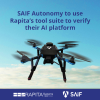CodeTEST® is a legacy tool made by Metrowerks® that was used to support testing of embedded software. Its primary uses are to measure software timing and structural code coverage. In spite of its nature as a legacy tool, many projects continue to use CodeTEST.
CodeTEST has been widely used in the embedded industry for performing structural code coverage and timing analysis. The tool was initially developed by AMC and later acquired by CodeWarrior and then Freescale. Deprecated a number of years ago, CodeTEST is no longer supported, licensed, or maintained.

One part of the CodeTEST solution was the CodeTEST Probe, a hardware device that connects to the target and collects trace data produced by the CodeTEST instrumentation. The hardware is no longer supported or maintained and no replacement parts are available for it. CodeTEST can be used in three modes, depending on where the code runs and on the data collection mechanism:
- CodeTEST Native. This allows code to be executed on host, and for verification data to be collected by CodeTEST for analysis.
- Software in-circuit. In this mode, instrumented applications are executed on the embedded target. Data for analysis by CodeTEST such as coverage and timing is stored within target memory.
- Hardware in-circuit. In this mode, the CodeTEST probe provides hardware support for tracing.
Why is CodeTEST still in use?
The first reason CodeTEST is still in use is that for a long time there was no clear alternative to using it. Also, risks were perceived in switching to a different approach – for example, it may be a concern that migrating to other tools could result in increased resource usage such as CPU utilization and memory overhead.
The risks of using CodeTEST today
Metrowerks CodeTEST is an unsupported tool that requires unsupported hardware. Continuing to base your verification strategy around the use of CodeTEST can introduce risks in several areas:
- Project delays may result if the probe fails, while attempts are made to source a (secondhand) replacement.
- New development risks arise when attempting to make changes to the current system (OS, compiler, process, hardware, certification (DO-178C), and build environment. The version of the tool you possess may not be compatible with the changes that are required.
- Changes you make to the development process may mean that CodeTEST is no longer qualifiable for DO-178B and DO-178C.
- It is no longer possible to address new software verification requirements that may emerge from discussions with the certifying authority or their representatives.
Replacing CodeTEST with RVS & the RTBx
RVS comprises a set of tools for performing on-target software verification activities. The toolsuite has been designed from the beginning to verify software running on resource-constrained targets. It has a wide range of features to provide minimal instrumentation overheads in code size, execution time and memory usage. RVS can therefore be adapted to fit almost any embedded target with any communication mechanism to extract verification data from the running target.
The RVS analysis process is very similar to the process used by CodeTEST (see Figure 1).
RVS automatically instruments software during compilation, and a small target-dependent library implements the instrumentation routine that collects evidence of the execution of the software on the target. This library can be implemented to support two different mechanisms for collecting data: traces and maps (see sidebar). For trace-based integrations, every time an instrumentation point is executed, a single ID is stored in a trace; this can be stored in RAM or pushed through an I/O port and collected by an external hardware device (such as a logic analyzer or the RTBx). For map-based integrations, every time an instrumentation point is executed, an element in a fixed size array in RAM is updated. On completion of the tests (or continuously), the map is then output from the system using any available communication mechanism.
RVS (Rapita Verification Suite) provides a verification framework with a collection of plug-ins for performing various software verification activities for embedded systems. Its features are an evolutionary improvement over older verification technologies such as CodeTEST.
Rapita's supporting services
Complementing the RVS product family, Rapita Systems offers a range of supporting services that provide a comprehensive verification solution. Services include:
- Target integration service. This allows RVS to be used as an “almost” drop-in replacement of current CodeTEST-based installations.
- Qualification service. Rapita Systems will adapt tests and documents to match the environment and intended use of RVS in satisfying DO-178B/C objectives.
- Training. Rapita Systems can provide on-site training courses for engineers covering various aspects of RVS, for example: integrating RVS into your development environment, using RapiCover for structural coverage analysis and using RapiTime to determine software worst-case execution time (WCET).
- RTBx. Rapita Systems also offers the RTBx, a data logger product designed to support effectively infinite verification data collection from the embedded target.
How does the instrumentation work?
For timing analysis, a trace of the execution of the program with positions in the code and timestamps are collected by RVS automatically. With RVS and the RTBx, the instrumentation routine typically writes an identifier to a general purpose I/O port or other address that can be monitored, collected and timestamped externally by the RTBx. The main difference between an RTBx and a CodeTEST probe is that an RTBx performs sampling of a number of I/O lines, typically 16 or 32. The CodeTEST probe performs a full bus snooping, therefore requiring access to data bus, address bus and control bus. The RTBx can be connected to the bus lines if required, but the preferred method of collecting data is using I/O ports. For an integration that combines RVS and an RTBx, each instrumentation point can typically be implemented with a single write of a constant to an address, which can be achieved in just a few assembly instructions.
To find out more about replacing CodeTEST with RVS, download our detailed technical whitepaper below.


 Rapita System Announces New Distribution Partnership with COONTEC
Rapita System Announces New Distribution Partnership with COONTEC
 Rapita partners with Asterios Technologies to deliver solutions in multicore certification
Rapita partners with Asterios Technologies to deliver solutions in multicore certification
 SAIF Autonomy to use RVS to verify their groundbreaking AI platform
SAIF Autonomy to use RVS to verify their groundbreaking AI platform
 What does AMACC Rev B mean for multicore certification?
What does AMACC Rev B mean for multicore certification?
 How emulation can reduce avionics verification costs: Sim68020
How emulation can reduce avionics verification costs: Sim68020
 Multicore timing analysis: to instrument or not to instrument
Multicore timing analysis: to instrument or not to instrument
 How to certify multicore processors - what is everyone asking?
How to certify multicore processors - what is everyone asking?
 Certifying Unmanned Aircraft Systems
Certifying Unmanned Aircraft Systems
 DO-278A Guidance: Introduction to RTCA DO-278 approval
DO-278A Guidance: Introduction to RTCA DO-278 approval
 ISO 26262
ISO 26262
 Data Coupling & Control Coupling
Data Coupling & Control Coupling
 DASC 2025
DASC 2025
 DO-178C Multicore In-person Training (Fort Worth, TX)
DO-178C Multicore In-person Training (Fort Worth, TX)
 DO-178C Multicore In-person Training (Toulouse)
DO-178C Multicore In-person Training (Toulouse)
 HISC 2025
HISC 2025















